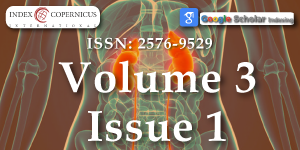Anti-glomerular basement membrane disease: A case report of an uncommon presentation
Main Article Content
Abstract
Anti-glomerular basement membrane (anti-GBM) disease is an uncommon autoimmune disease that classically presents as an aggressive necrotizing and crescentic glomerulonephritis (CG), with or without pulmonary hemorrhage, and typically does not relapse. The pathologic hallmark is linear staining of GBM for Immunoglobulin G (IgG) which binds to the alpha-3 chain of type IV collagen. Recent reports have noted the occurrence of anti-GBM disease with atypical clinical presentations. We describe a case of a 22-year-old female presenting an anti-GBM disease with typical histological features with a singular clinical presentation with lower limb edema, elevated serum creatinine and nephrotic range proteinuria. Renal biopsy showed signs of chronicity and direct immunofluorescence microscopy demonstrated diffuse, intense linear positivity for IgG. All serologic tests were negative, including anti-GBM antibodies. Hence, a diagnosis of atypical anti-GBM disease was made. The patient was treated initially with mycophenolate mofetil and corticosteroids. After 3 months she began to aggravate renal function so mycophenolate of mofetil was discontinued and a low dose cyclophosphamide was initiated.
Article Details
Copyright (c) 2019 Silva N, et al.

This work is licensed under a Creative Commons Attribution 4.0 International License.
Lerner RA, Glassock RJ, Dixon FJ. The role of anti-glomerular basement membrane antibody in the pathogenesis of human glomerulonephritis. J Exp Med. 1967; 126: 989–1004. Ref.: http://tinyurl.com/y56k3z4p
Pedchenko V1, Bondar O, Fogo AB, Vanacore R, Voziyan P, et al. Molecular architecture of the Goodpasture autoantigen in anti-GBM nephritis. N Engl J Med. 2010; 363: 343–354. Ref.: http://tinyurl.com/y69wrgpu
Kalluri R1, Wilson CB, Weber M, Gunwar S, Chonko AM, et al. Identification of the α3 chain of Type IV collagen as the common autoantigen in anti-basement membrane disease and Goodpasture syndrome. J Am Soc Nephrol. 1995; 6: 1178–1185. Ref.: http://tinyurl.com/y3t7k2tn v
Troxell ML, Houghton DC. Atypical anti-glomerular basement membrane disease. Clin Kidney J. 2016; 9: 211–221. Ref.: http://tinyurl.com/y3yvgnbs
Cui Z, Turner N, Zhao MH. Antiglomerular basement membrane disease: clinical features and diagnosis. 4th edn. Oxford: Oxford University Press, Oxford Textbook of Clinical Nephrology. 2016; 599–605.
Savage CO, Pusey CD, Bowman C, Rees AJ, Lockwood CM. Antiglomerular basement membrane antibody mediated disease in the British Isles 1980–1984. BMJ. 1986; 292: 301–304. Ref.: http://tinyurl.com/y5gvex96
Silvariño R, Noboa O, Cervera R. Anti-glomerular basement membrane antibodies. Isr Med Assoc J. 2014; 16: 727–732. Ref.: http://tinyurl.com/y23wsxe2
Ohlsson S1, Herlitz H2, Lundberg S3, Selga D1, Mölne J, et al. Circulating anti-glomerular basement membrane antibodies with predominance of subclass IgG4 and false negative immunoassay test results in anti-glomerular basement membrane disease. Am J Kidney Dis. 2014; 63: 289–293. Ref.: http://tinyurl.com/y2l6gd6h
Levy JB1, Turner AN, Rees AJ, Pusey CD. Long-term outcome of anti-glomerular basement membrane antibody disease treated with plasma exchange and immunosuppression. Ann Intern Med. 2001; 134: 1033-1042. Ref.: http://tinyurl.com/y2cq5fvm
Taylor DM1, Yehia M, Simpson IJ, Thein H, Chang Y, et al. Anti-glomerular basement membrane disease in Auckland. Intern Med J. 2012; 42: 672–676. Ref.: http://tinyurl.com/y2sncagm
Cui Z1, Zhao MH, Singh AK, Wang HY. Antiglomerular basement membrane disease with normal renal function. Kidney Int. 2007; 72: 1403–1408. Ref.: http://tinyurl.com/y5b664mr
Olaru F, Wang XP, Wentian Luo W, Ge L, Miner JH, et al. Proteolysis breaks tolerance toward intact alpha 345(IV) collagen, eliciting novel anti–glomerular basement membrane autoantibodies specific for alpha345NC1 hexamers. J Immunol. 2013; 190: 1424–1432. Ref.: http://tinyurl.com/yywch5a4
Yang R1, Hellmark T, Zhao J, Cui Z, Segelmark M, et al. Levels of epitope-specific autoantibodies correlate with renal damage in anti-GBM disease. Nephrol Dial Transplant. 2009; 24: 1838–1844. Ref.: http://tinyurl.com/yxwae9oo
Segelmark M1, Hellmark T, Wieslander J. The prognostic significance in goodpasture's disease of specificity, titre and affinity of anti-glomerular-basement-membrane antibodies. Nephron Clin Pract. 2003; 94: 59–68. Ref.: http://tinyurl.com/yy29j2d3
Nasr SH1, Collins AB2, Alexander MP1, Schraith DF3, Herrera Hernandez L, et al. The clinicopathologic characteristics and outcome of atypical anti-glomerular basement membrane nephritis. Kidney Int. 2016; 89: 897-908. Ref.: http://tinyurl.com/y342zsyp
Yao S, Chen M, Liu Y. Atypical anti-glomerular basement membrane disease with IgA nephropathy: A case report. Int J Clin Exp Med. 2017; 10: 15611-15614. Ref.: http://tinyurl.com/y5ddf9bf
Balasubramaniyan T, Dhanapriya J, Dineshkumar T, Maasila AT, Arivazhagan S, Rajasekar D, et al. Atypical anti-glomerular basement membrane disease superimposed on IgA nephropathy. J Integr Nephrol Androl. 2017; 4: 26-28. Ref.: http://tinyurl.com/y696vryy

